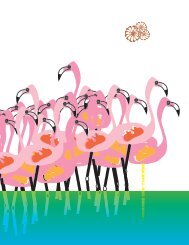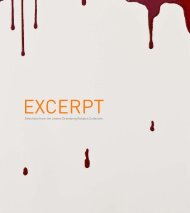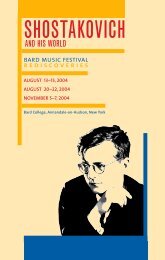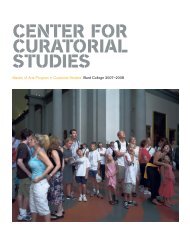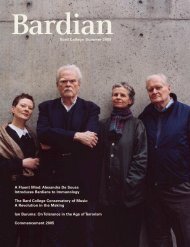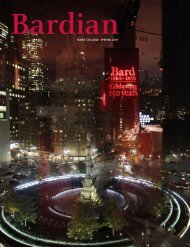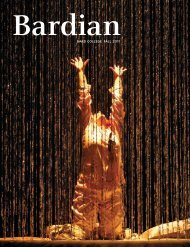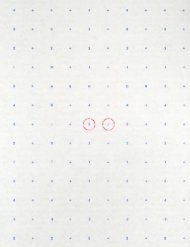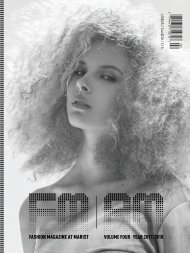FLLAC-EXH-CAT-2008 no cover
Create successful ePaper yourself
Turn your PDF publications into a flip-book with our unique Google optimized e-Paper software.
EXCERPT<br />
Selections from the Jeanne Greenberg Rohatyn Collection<br />
Barry X Ball<br />
Tamy Ben-Tor<br />
Huma Bhabha<br />
Glenn Brown<br />
Jennifer Cohen<br />
Benjamin Edwards<br />
Katy Grannan<br />
David Hammons<br />
Sarah Lucas<br />
Julie Mehretu<br />
Marilyn Minter<br />
Wangechi Mutu<br />
Tim Noble and Sue Webster<br />
Richard Prince<br />
Aïda Ruilova<br />
Laurie Simmons<br />
Rudolf Stingel<br />
Piotr Uklański
Excerpt: Selections from the Jeanne Greenberg Rohatyn Collection<br />
September 26, <strong>2008</strong> – January 4, 2009<br />
This catalogue has been published in conjunction with the exhibition Excerpt: Selections from the Jeanne Greenberg Rohatyn<br />
Collection, organized and presented at the Frances Lehman Loeb Art Center, Vassar College, and curated by Mary-Kay Lombi<strong>no</strong>.<br />
ISBN # 978-0-9820606-0-5<br />
Designed by Francie Soosman<br />
Printed by Quality Printing Company, Pittsfield Massachusetts in an edition of 3,000 copies.<br />
Text © Vassar College, <strong>2008</strong>. Images © the artists.<br />
No part of the contents of this book may be reproduced, in whole or in part,<br />
without the permission of the publisher.<br />
Contents<br />
Ack<strong>no</strong>wledgments 4<br />
mary-kay lombi<strong>no</strong><br />
jeanne greenberg rohatyn<br />
Director’s Foreword 6<br />
james mundy<br />
The Pleasure of Looking, an interview with Jeanne Greenberg Rohatyn 8<br />
mary-kay lombi<strong>no</strong><br />
The Frances Lehman Loeb Art Center<br />
Vassar College, Box 703<br />
124 Raymond Avenue<br />
Poughkeepsie, NY 12604-0703<br />
Telephone 845 437 5632<br />
Fax 845 437 5955<br />
http://fllac.vassar.edu<br />
Works in the Exhibition 19<br />
Exhibition Checklist 76<br />
Image permissions and credits 80
Ack<strong>no</strong>wledgments<br />
Special Thanks<br />
On behalf of the Frances Lehman Loeb Art Center and the entire Vassar College community, I would<br />
like to extend heartfelt thanks to Jeanne Greenberg Rohatyn for her time, generosity, and willingness<br />
to share her vision with our audience. She has been an extraordinarily helpful partner in selecting the<br />
works for the exhibition, coordinating the catalogue, and offering her insight in the interview printed<br />
here. I thank Jeanne and her husband Nicholas Rohatyn for agreeing to part with their compelling<br />
works for the extended loan period.<br />
This exhibition and its publication could <strong>no</strong>t have come to fruition without the dedication,<br />
assistance, and attentiveness of several individuals. I would like to thank all of my colleagues at<br />
The Frances Lehman Loeb Art Center. Director, James Mundy first suggested that I meet with Jeanne<br />
when I began as Curator here almost three years ago. His leadership and endorsement of this<br />
exhibition have been steadfast ever since. Special thanks go to Registrar, Joann Potter who skillfully<br />
coordinated the loans and transportation of the artwork and to Preparator Bruce Bundock for his<br />
flexibility and finesse in the installation of this broad range of works. Francine Brown, Jennifer Cole,<br />
Beverly Doppel, Karen Casey Hines, Nicole Roylance, and Patti Phagan have all provided essential<br />
support and encouragement. In the Office of College Relations at Vassar College, Janet Allison,<br />
George Laws, Emily Darrow, and Jeff Kosmacher contributed their valuable time and expertise.<br />
I am pleased for the opportunity to work with Francie Soosman to whom I am deeply grateful for<br />
her hard work, patience, and talent in designing the catalogue as well as the invitation, banner, and<br />
wall text for the exhibition.<br />
I am very thankful to members of the Salon 94 staff including Dede Dennehy, Christian Dietkus,<br />
David Fierman, Alissa Friedman, Andrew Post, Fabienne Stephan, and Sirui Yan who provided<br />
assistance with every aspect of this project and were each a pleasure to work with. I would also like<br />
to thank the following galleries for replying to my queries and facilitating permission to reproduce<br />
the images in this publication: Sadie Coles HQ, Paula Cooper Gallery, Zach Feuer Gallery, Gagosian<br />
Gallery, Salon 94, Sikkema Jenkins & Co., The Project, Greenberg Van Doren Gallery, Sperone<br />
Westwater Gallery, White Columns, and David Zwirner, New York.<br />
Above all, I want to ack<strong>no</strong>wledge the artists whose work is included in the exhibition to whom<br />
I owe a dept of gratitude for their great talent and imagination in creating the artworks on display in<br />
the exhibition and on the pages of this publication.<br />
—Mary-Kay Lombi<strong>no</strong>, The Emily Hargroves Fisher 1957 and Richard B. Fisher Curator<br />
I would like to thank the entire staff of Salon 94 for all of their work on this personal project.<br />
With a special thanks to Christian Dietkus and Sirui Yan for their tremendous organizational efforts<br />
in a short period of time, and to David Fierman for overseeing our purchases, and Andrew Post for<br />
coordinating the artworks’ shipment. I would also like to extend my appreciation to Dede Dennehy,<br />
who manages our home and collection with such grace. To the artists with whom I share a deep<br />
respect, and often friendship, and collaboration, I am indebted. Mostly, I would like to thank my<br />
husband and partner, Nick Rohatyn, who has lovingly joined me in my passion to collect.<br />
Jeanne Greenberg Rohatyn<br />
Standing in front of Marilyn Minter, Glazed, 2006<br />
—Jeanne Greenberg Rohatyn<br />
4<br />
5
Director’s Foreword<br />
It is always a particular pleasure for Vassar College to celebrate the accomplishments of one of her<br />
alumni. For me this holds especially true in the case of Jeanne Greenberg Rohatyn, Vassar class of<br />
1989, who is truly the spiritual descendent of a number of adroit art lovers and collectors who were<br />
educated over the past 140 years by Vassar’s art department, one of the best in the country. Vassar’s<br />
continuing encounter with contemporary art dates back to its acquisition in 1864 of a large collection<br />
of American paintings acquired directly from the artists by Elias Magoon in the 1850s and has<br />
continued to this day thanks to faculty such as Agnes Rindge and Linda Nochlin who brought<br />
important artists to campus; and well-educated collectors and do<strong>no</strong>rs such as Edna Bryner Schwab,<br />
class of 1907, who added significant works by the Stieglitz Circle to the collection and Blanchette<br />
Hooker Rockefeller, class of 1931, and Katherine Sanford Deutsch, class of 1940 whose gifts of<br />
European and American postwar paintings have distinguished Vassar’s holdings. Vassar graduates<br />
without fortunes to invest in the market have also contributed as tastemakers in the contemporary<br />
art world. The advocacy and writings on contemporary art by figures such as Katherine Woolf Kuh,<br />
class of 1925 and Aline Berstein Saarinen, class of 1935 left their marks on a large segment of the<br />
gallery and museum going public of America.<br />
I met the then Jeanne Greenberg shortly after I returned to Vassar and the Frances Lehman<br />
Loeb Art Center opened in the early 1990s when she was director of Jeffrey Deitch, Inc. Jeanne was<br />
full of enthusiasm for contemporary art and wondered rightly why we did <strong>no</strong>t do more with it at the<br />
new Art Center. Certainly, while my rational mind could <strong>no</strong>t argue with the fact that contemporary<br />
art had played a major role in Vassar’s collecting of art since its founding, the nature of our curatorial<br />
expertise was for the moment rooted in historical interests and studies. Such a focus was in keeping<br />
with the lion’s share of the curriculum in its historical focus. But Jeanne’s enthusiasm was infectious<br />
and soon we were planning an exhibition of the recent drawings of Peter Halley, a collaborative<br />
project that opened at Vassar during the summer of 1996 and an exhibition that introduced me to<br />
the peculiar pleasure of working with an artist who was alive and part of the exhibition process.<br />
This was something for which I was very grateful to Jeanne for facilitating and I <strong>no</strong>ted her ease in<br />
working with creative individuals, a talent that could only spell success in her chosen field. It was<br />
clear to me then, when she was only a relatively recent alumna of Vassar, that Jeanne’s intelligence and<br />
commitment to the world of contemporary art was sincere and prescient. Her accomplishments since<br />
that time have certainly lived up to what was then a clear potential to become an important force in<br />
the art world. It seems fitting at this point to reflect on Jeanne Greenberg Rohatyn’s contributions to<br />
the dizzying, high-octane world of contemporary art at a moment that might be termed, were she an<br />
artist, “mid-career.”<br />
Much has changed at the Frances Lehman Loeb Art Center with respect to contemporary art<br />
since the early 1990s and we have <strong>no</strong>w on staff a curator, Mary-Kay Lombi<strong>no</strong>, who is a specialist<br />
in this volatile field where history has <strong>no</strong>t had the opportunity to sort out the meaningful from the<br />
transitory artistic figures. To see the excellent results of this collaboration between curator and<br />
collector is very gratifying, indeed. It is my hope that this exhibition will also serve as a model to<br />
others that one passion for art can integrate and promote professional and domestic pleasure and<br />
satisfaction.<br />
—James Mundy, class of 1974, The Anne Hendricks Bass Director<br />
6<br />
7
The Pleasure of Looking<br />
an interview with Jeanne Greenberg Rohatyn by Mary-Kay Lombi<strong>no</strong><br />
Art advisor, independent curator, and collector Jeanne Greenberg Rohatyn (Vassar class of 1989)<br />
founded Salon 94 on the first floor of her Manhattan home in 2002, to be an experimental project<br />
space for emerging and mid-career contemporary artists. Much of her own collection, assembled<br />
over the last decade with her husband Nicholas Rohatyn, can be found on display just upstairs, in<br />
her family’s living space. Ms. Rohatyn, who studied Art History at Vassar College and went on to<br />
earn a graduate degree from New York University’s Institute of Fine Art, became familiar with<br />
contemporary art at very young age. Her father is a prominent art dealer and her mother is an art<br />
educator, and as a result, she is completely at home with the <strong>no</strong>tion of living with art. Ms. Rohatyn’s<br />
collection, which includes artist portraits of her and her family, reflects a personal connection to the<br />
artists she supports and reveals how her passion for art permeates both her private and professional<br />
life. While the work shows evidence of a diverse set of social, political, ethnic, and intergenerational<br />
interests, it is bound together in this distinguished collection, which illustrates the personal preferences<br />
of an experienced collector with a well-trained eye, but also reveals a rare intimacy and deep understanding<br />
of the power of the art of our time.<br />
MKL What were your first memorable art experiences as a child?<br />
JGR In 1970, a truck pulled up to our house, in suburban St. Louis, and unloaded a large crate, in<br />
it was a Morris Louis painting. Squeezed into our living room—a small cozy space with over stuffed<br />
madras couches, walled with taxidermy animal heads, this painting appeared as if an alien had landed.<br />
My mother looked at this veiled monster, and an<strong>no</strong>unced that either the house or the painting had to<br />
go. The following day, my father went out and bought an e<strong>no</strong>rmous Tudor house.<br />
Florine Stettheimer<br />
Natatorium Undine, 1927<br />
Oil and encaustic on canvas<br />
50 1/2 x 60 in.<br />
8<br />
9
He hired architectural students at Washington University to re<strong>no</strong>vate—they built thick sheetrock walls<br />
to attach to the historic wood panels for hanging. It was a house bought for art, sparingly outfitted<br />
with just the essentials. Keeping with the minimalist tenets of the time, the walls were gallery white.<br />
Yet the house itself, built after the 1904 worlds fair, had its own nature—it was detailed ornately<br />
with carved lions on its grand stairwell, coiffured ceilings, and a sunroom with leaded-glass windows.<br />
The pairing of my parents emerging collection and this house gave me a solid sense that art<br />
pulls one out of the domestic. Yet, art always needs a lot of help and the character of a place<br />
allowed the art to breathe in a dynamic way.<br />
In order to collect full time, my father became an art dealer in 1971. He showed and collected<br />
the artists of his generation: Roy Lichtenstein and Andy Warhol followed by Richard Serra, Donald<br />
Judd, and Dan Flavin. In 1975, Warhol sent The Greenberg Gallery a role of purple Mao wallpaper<br />
for his upcoming exhibit there. My father brought it home and used it to wallpaper the powder<br />
room. During the opening evening’s celebrations, a shy wigged Warhol hung out in this bathroom,<br />
signing Campbell’s Soup cans nicked from our pantry by my parents’ friends. I stood below him—<br />
and when he had a break he would doodle bananas on a napkin for me. It was much later when I<br />
was at Vassar that I saw the Velvet Underground album <strong>cover</strong> that features Warhol’s banana drawings.<br />
MKL As a student at Vassar, you studied Art History. Is there anything in particular about your college<br />
education that informs your relationship with art today?<br />
Installation view<br />
The Florine Stettheimer Collapsed Time Salon, 1995<br />
JGR The museum was always a great walk-through. There, I dis<strong>cover</strong>ed Florine Stettheimer’s 1927<br />
Natatorium Undine. The painting became the inspiration for an exhibition I mounted years later<br />
in 1995 in the green room of the Gramercy Hotel at the Gramercy Contemporary Art Fair, entitled<br />
The Florine Stettheimer Collapsed Time Salon. I was fascinated with the pre-war attitudes of the<br />
Stettheimer sisters and their famed salon at Alwyn Court. They represented great contradictions from<br />
frivolous to serious—Marcel Duchamp taught the heiresses French while they sat for manicures; yet<br />
each of the women was devoted to her own discipline (writer, painter, dollhouse maker). The salon<br />
was occasion for Florine to dramatically unveil her paintings, revealing her fantastic paintings of and<br />
to her artistic friends. Yet, her ultimate place as hostess unnerved me. We recreated her salon in<br />
spirit—combining works by Warhol, Jeff Koons, and a then emerging Elizabeth Peyton, and borrowed<br />
from Columbia University some of Stettheimer’s greatest paintings—including her self-portrait as the<br />
nude Olympia. Imitating her aesthetic, we <strong>cover</strong>ed the walls with cellophane, and Virgil Thomas was<br />
played on the pia<strong>no</strong>.<br />
10<br />
11
MKL How did you begin collecting?<br />
JGR I began purchasing art when I was still in high school. I collected what my parents did <strong>no</strong>t. It<br />
started with ceramics—my first purchase was a ceramic vessel by Richard deVor. My father, a hardcore<br />
minimalist, would have never purchased what he stills consider to be tchotki. I later moved<br />
onto artists of my generation. As soon as I earned a salary—I bought art. As a graduate student at<br />
the Institute of Fine Arts in New York, I was Kurt Vardendoe’s teaching assistant. (It was neither<br />
glamorous <strong>no</strong>r academic, as I spent most of my time in the slide library hunting slides for his weekly<br />
lectures.) With my earnings I purchased a Sigmar Polke print, which I later sold. After making a sale<br />
at the Stettheimer show, I proceeded down stairs to the Andrea Rosen Gallery, where I spent an hour<br />
sifting through the Wolfgang Tillmans portfolio. I purchased three small photographs—the first of<br />
many to come into my collection. I made my first big purchase at the 1997 Chicago Art Fair. It was<br />
a recently completed Kara Walker cut-paper installation entitled World’s Exposition. I was there<br />
with my husband Nick (though we were <strong>no</strong>t yet married), and he asked where I would put it. I<br />
responded that I would have a wall for it someday. I buy very quickly, and on instinct. Years later,<br />
Nick and I made our first purchase as a couple, Chris Ofili’s diptych, Y + X= 0, which we had seen<br />
in 2000 at The Saatchi Gallery in London. When it came up for auction a few years later, we purchased<br />
it. Even today, whenever I make money, it goes towards an art purchase.<br />
MKL Before you opened Salon 94, you worked as a gallery director, an independent curator, and an<br />
art consultant. What aspects of that experience inform your relationship with art today?<br />
JGR I continue to practice as a curator, gallery director, and consultant. While being involved in all<br />
of these aspects of handling art and artists seems old school, I can<strong>no</strong>t imagine abandoning any one<br />
side. When a work of art is offered to me, either from a dealer or an artist, I quickly place the artwork<br />
in a venue, both real and imagined. I conceive group shows around the object, or situate it in a collector’s<br />
home, or an institutional collection among other significant works of art. I only pursue an artwork<br />
once it fits into one of these fantasy venues. As a curator, one is constantly thinking of artworks in<br />
relation to a<strong>no</strong>ther. In our home, I am more open to accidental and unlikely relationships between<br />
works. Placing Huma Bhabha’s raw figure in wood and clay near the refined marble busts of Barry<br />
X Ball brings out the classicism and yet the baroque in both.<br />
When I curated Casi<strong>no</strong> 2001, the first Quadrennial exhibition for S.M.A.K., the Municipal<br />
Museum of Contemporary Art in Ghent, Belgium, the charismatic director Jan Hoet insisted that the<br />
Chris Ofili<br />
Y + X= 0, 2000<br />
Collection of Jeanne Greenberg and Nicolas Rohatyn, New York<br />
12<br />
13
show be vast, filling three venues, with more than sixty artists. His attitude taught me showmanship,<br />
while at the same time, my budget was minimal, and so I learned to be resourceful. To realize the<br />
installation of Piotr Uklański’s work, for example, I found myself enlisting the local fire department<br />
to help install several meters of holiday lights that lined the façade of the antiquities museum. Today,<br />
while my platform is smaller in scale, I do try to re-capture the flair and drama of these earlier largescale<br />
projects.<br />
MKL What attracted you to contemporary art?<br />
JGR I like being in dialogue with artists. Many are among my close friends. Gregory Crewdson,<br />
whom I met shortly after moving to New York in 1990, and I imagined a show called Suburbia while<br />
chatting about Steven Spielberg movies and our favorite short story, The Swimmer by John Cheever.<br />
And, while this project was never realized, in 1999 we ultimately co-curated A<strong>no</strong>ther Girl/A<strong>no</strong>ther<br />
Planet, which introduced new narrative photography. The show grew from comparing studio visits—<br />
Gregory teaching at Yale, and me in New York and London. I continue to work with Katy Grannan<br />
and Malerie Marder, whose work was featured. Inspired by this young work, Gregory later began to<br />
place figures in his own landscape photographs.<br />
MKL What kinds of qualities do you look for in an artwork that you are considering for purchase?<br />
JGR An element of surprise. The works must have beauty, concept, and the pleasure of looking. I<br />
also seek out raw talent in an artist.<br />
MKL Once you begin collecting a particular artist’s work, do you form a bond to that artist, or do<br />
you feel a certain commitment to continuing to support him or her?<br />
Installation view<br />
Marilyn Minter exhibition at Salon 94<br />
JGR It is a luxury to support an artist throughout his or her career. As a patron of young artists, I<br />
often buy early on, yet I am priced out of their market soon thereafter. I have made a commitment<br />
to a handful of artists, whom I will continue to support. I will keep working to afford their work.<br />
Katy Grannan makes a portrait of our children every year that we use as our signature holiday<br />
card. We also collect her work in depth.<br />
14<br />
15
MKL As you live with an artwork over a long period, how does your relationship with that artwork<br />
evolve with time?<br />
JGR At home, I regularly move artworks around, playing with their context in relation to other works.<br />
Likewise, artwork in this exhibition and its Vassar installation might acquire new meaning. The Richard<br />
Prince car hood shown next to a Mark Rothko painting will look classical and monastic—yet at<br />
home, next to an Adam McEwen gum painting and a Takashi Murakami painting—it looks dangerous,<br />
Pop, and trashy. Sometimes it takes years for a work to look classic—with other works it happens<br />
overnight. When I bought Sarah Lucas’ Notorious Dream, I instantly thought about it in relation to<br />
Hans Bellmer and to Pablo Picasso portraits of seated woman—yet in our livingroom—these are<br />
mere passing historical <strong>no</strong>tations to a deeply radical work.<br />
MKL Are there works in your collection that are difficult to live with?<br />
JGR Yes, Rineke Dijkstra’s nude photographs of new mothers with their infants, a series she completed<br />
in 1994. These fill everyone with discomfort—especially men. When they were hung in our livingroom,<br />
even seasoned curators turned their backs on it. They are <strong>no</strong>w a promised gift to The Museum of<br />
Modern Art, New York.<br />
MKL As a patron and producer of many artists’ projects, how do you see your role in the artistic<br />
vision of an artist?<br />
JGR I like to produce projects that are performative in nature. I am planning with Art Production<br />
Fund a Sylvie Fleury Fluxus Symphony at The Armory Show this February. Artists often find Salon 94<br />
to be a safe place to make new work. Perhaps because it is just off the grid e<strong>no</strong>ugh that it allows them<br />
to experiment. Wangechi Mutu made her first large-scale installation there, and for the past several<br />
years Tamy Ben-Tor has used it as a space to develop her characters. My intent is to give artists the<br />
opportunity to create projects that are <strong>no</strong>n-commercial in nature.<br />
MKL Are there any artworks that you wish you had bought, but are <strong>no</strong> longer available?<br />
JGR Many! While they are seemingly in opposite camps—the two artists who have influenced me<br />
most are David Hammons and Jeff Koons. I am sorry that I do <strong>no</strong>t own more of their works. I have<br />
been lucky, as many have passed through my hands as a dealer.<br />
Installation view<br />
Rineke Dijkstra photographs and Mountain Girls, a mural by Chiho Aoshima<br />
16<br />
17
Works in the Exhibition
No. 1<br />
Barry X Ball<br />
The artist, taking the life-cast head of his New York gallerist as a jumping-off point, in a concerted effort to<br />
reinvigorate the sub-genre of romantic portrait sculpture, has here conjoined his signature fever-pitch execution<br />
intensity and a newfound conceptual tenderness. Realized as a mirror-image of the subject, at 85% scale, in an<br />
exceptional specimen of dramatically-figured, exuberantly-colored translucent onyx, exhibiting a layered surface<br />
suffused with a ‘sfumato’ overlay of foliate relief and coincident miniscule diagonal / radial flutes, the stony<br />
surrogate captures, in soft Galatean contravention of its obdurate materiality, a moment of poignant reverie.<br />
The artist-designed integral / modular base, it’s tapering parabolic sweep flowing into the sculpture’s glass-polished<br />
flute stem (which, in turn, terminates in a silhouetted arboreal fringe), conceived in parallel with the sculpture,<br />
precisely-fabricated in stainless steel, limestone, acrylic-spray-lacquered aluminum and wood (and a variety of<br />
subsidiary materials) by a studio-coordinated consortium of disparate fabricators, is reminiscent, alternately,<br />
of traditional ‘socles’ and mid-20th-century Modernist furniture pedestals. The resultant deceptively-diminutive<br />
ensemble, created with deep reverence for and specific focus on the history of sculpture, makes an expansive<br />
case for the critical reconsideration of prevailing contemporary practice, while simultaneously probing both the<br />
subject’s psychology and her complex relationship to the artist, 2007-<strong>2008</strong><br />
20<br />
21
No. 2<br />
Tamy Ben-Tor<br />
Exotica, The Rat, and The Liberal, 2005<br />
Photographs from a live performance at Salon 94<br />
22<br />
23
No. 3<br />
Tamy Ben-Tor<br />
The Tea Lover, 2005<br />
Film still<br />
24<br />
25
No. 5<br />
Glenn Brown<br />
Holy Virgin, 2003<br />
No. 4<br />
Huma Bhabha<br />
Sleeper, 2005<br />
26<br />
27
No. 6<br />
Jennifer Cohen<br />
Grey Line in Three Parts (i), <strong>2008</strong><br />
28
No. 7<br />
Benjamin Edwards<br />
Decoherence, 2001<br />
31
No. 9<br />
Katy Grannan<br />
Alexander Kay Rohatyn,<br />
YMCA, 2001<br />
No. 8<br />
Katy Grannan<br />
Alexander Kay Rohatyn,<br />
2000<br />
32<br />
33
No. 11<br />
Katy Grannan<br />
Alexander Kay and<br />
Colette Fay Rohatyn, 2003<br />
No. 10<br />
Katy Grannan<br />
Colette Fay and Alexander Kay Rohatyn, 2002<br />
34<br />
35
No. 12<br />
No. 13<br />
Katy Grannan<br />
Colette Fay and Alexander Kay Rohatyn, 2004<br />
Katy Grannan<br />
Alexander Kay, Clara Michele, and Colette Fay Rohatyn, 2005<br />
36<br />
37
No. 14<br />
No. 15<br />
Katy Grannan<br />
Clara Michele, Colette Fay, and Alexander Kay Rohatyn, 2006<br />
Katy Grannan<br />
Alexander Kay, Clara Michele, and Colette Fay Rohatyn, 2007<br />
38<br />
39
No. 16<br />
David Hammons<br />
Don’t Bite The Hand That Feeds, 1974<br />
40<br />
41
No. 18<br />
David Hammons<br />
Hair Relaxer, 2001<br />
No. 17<br />
David Hammons<br />
Flight Fantasy, 1995 (detail)<br />
42<br />
43
No. 20<br />
Sarah Lucas<br />
Stars at a Glance, 2007<br />
No. 19<br />
Sarah Lucas<br />
The Notorious Dream, 2004<br />
45
No. 21<br />
Julie Mehretu<br />
Dispersion, 2002<br />
46<br />
47
No. 22<br />
No. 23<br />
Julie Mehretu<br />
Excerpt (molotov cocktail), 2003<br />
Julie Mehretu<br />
Excerpt (riot), 2003<br />
48<br />
49
No. 25<br />
Marilyn Minter<br />
Nose Drops, 2007<br />
No. 24<br />
Marilyn Minter<br />
Glazed, 2006<br />
50<br />
51
No. 26<br />
Wangechi Mutu<br />
People in glass towers<br />
should <strong>no</strong>t imagine us, 2003<br />
52<br />
53
No. 27<br />
Wangechi Mutu<br />
The Mare, 2007<br />
55
No. 28<br />
Tim Noble and Sue Webster<br />
Twin Suicide, 2005<br />
56
No. 29<br />
No. 30<br />
Richard Prince<br />
Untitled (de Kooning), 2007<br />
Richard Prince<br />
Untitled (de Kooning), 2007<br />
58<br />
59
No. 31<br />
Richard Prince<br />
Untitled, <strong>2008</strong><br />
60<br />
61
No. 32<br />
No. 33<br />
Aïda Ruilova<br />
Alright, 2005<br />
Film still<br />
Aïda Ruilova<br />
Life Like, 2006<br />
Film still<br />
62<br />
63
No. 34<br />
Aïda Ruilova<br />
Cello, 2007<br />
Film stills<br />
64<br />
65
No. 35<br />
No. 35<br />
Laurie Simmons<br />
The Music of Regret, 2006<br />
Film still from Act 1<br />
Laurie Simmons<br />
The Music of Regret, 2006<br />
Film still from Act 3, featuring Alvin Ailey II dancers<br />
66<br />
67
No. 35<br />
Laurie Simmons<br />
The Music of Regret, 2006<br />
Film still from Act 2, featuring Meryl Streep<br />
68<br />
69
No. 36<br />
Rudolf Stingel<br />
Untitled, 1989<br />
No. 37<br />
Rudolf Stingel<br />
Untitled (After Sam), 2005<br />
71
No. 38<br />
Piotr Uklański<br />
The Nazis, 1999 (detail)<br />
72 73
No. 39<br />
Piotr Uklański<br />
Untitled (Carotid Artery), 2007<br />
74
Exhibition checklist<br />
Dimensions are given in inches, height preceding width, preceding depth.<br />
All works are from the collection of Jeanne Greenberg Rohatyn and<br />
Nicolas Rohatyn, New York unless otherwise indicated.<br />
Barry X Ball (b. 1955 Pasadena, California; lives in New York)<br />
1. The artist, taking the life-cast head of his New York<br />
gallerist as a jumping-off point, in a concerted effort to<br />
reinvigorate the sub-genre of romantic portrait sculpture,<br />
has here conjoined his signature fever-pitch execution<br />
intensity and a newfound conceptual tenderness. Realized<br />
as a mirror-image of the subject, at 85% scale, in an<br />
exceptional specimen of dramatically-figured, exuberantlycolored<br />
translucent onyx, exhibiting a layered surface<br />
suffused with a ‘sfumato’ overlay of foliate relief and<br />
coincident miniscule diagonal / radial flutes, the stony<br />
surrogate captures, in soft Galatean contravention of<br />
its obdurate materiality, a moment of poignant reverie.<br />
The artist-designed integral / modular base, it’s tapering<br />
parabolic sweep flowing into the sculpture’s glass-polished<br />
flute stem (which, in turn, terminates in a silhouetted<br />
arboreal fringe), conceived in parallel with the sculpture,<br />
precisely-fabricated in stainless steel, limestone, acrylicspray-lacquered<br />
aluminum and wood (and a variety of<br />
subsidiary materials) by a studio-coordinated consortium<br />
of disparate fabricators, is reminiscent, alternately, of<br />
traditional ‘socles’ and mid-20th-century Modernist<br />
furniture pedestals. The resultant deceptively-diminutive<br />
ensemble, created with deep reverence for and specific<br />
focus on the history of sculpture, makes an expansive<br />
case for the critical reconsideration of prevailing<br />
contemporary practice, while simultaneously probing<br />
both the subject’s psychology and her complex<br />
relationship to the artist, 2007-<strong>2008</strong><br />
Mexican Onyx<br />
13 3/8 x 6 3/8 x 7 1/8<br />
Tamy Ben-Tor<br />
(b. 1975 Jerusalem, Israel; lives in New York)<br />
2. Erotica, The Rat, and The Liberal, 2005<br />
Performed at Salon 94 as part of PERFORMA05<br />
Video documentation by Yoni Brook<br />
9 minutes, 30 seconds<br />
3. The Tea Lover, 2005<br />
Single-channel video with sound transferred to DVD<br />
4 minutes, 51 seconds<br />
Huma Bhabha<br />
(b. 1962 Karachi, Pakistan; lives in Poughkeepsie, New York)<br />
4. Sleeper, 2005<br />
Mixed media<br />
23 2/3 x 18 x 75<br />
Glenn Brown<br />
(b. 1966 Hexham, Northumerland, England; lives in London)<br />
5. Holy Virgin, 2003<br />
Oil on panel<br />
44 7/8 x 30 1/8<br />
Jennifer Cohen<br />
(b. 1970 Brooklyn, New York; lives in Brooklyn)<br />
6. Grey Line in Three Parts (i), <strong>2008</strong><br />
Wood, cellucly, cement, glue, leather shoe, fabric<br />
36 x 20 x 12 1/2<br />
Benjamin Edwards<br />
(b. 1970 Iowa City, Iowa; lives in Washington, DC)<br />
7. Decoherence, 2001<br />
Acrylic, texture mediums, foam, spray paint<br />
96 x 144<br />
Katy Grannan<br />
(b. 1969 Arlington, Massachusetts; lives in Berkeley,<br />
California)<br />
8. Alexander Kay Rohatyn, 2000<br />
C-print<br />
7 1/2 x 9 3/4<br />
9. Alexander Kay Rohatyn, YMCA, 2001<br />
C-print<br />
7 x 10<br />
10. Colette Fay and Alexander Kay Rohatyn, 2002<br />
C-print<br />
9 1/2 x 7 1/2<br />
11. Alexander Kay and Colette Fay Rohatyn, 2003<br />
C-print<br />
7 1/4 x 9 1/2<br />
12. Colette Fay and Alexander Kay Rohatyn, 2004<br />
C-print<br />
10 x 7<br />
13. Alexander Kay, Clara Michele, and<br />
Colette Fay Rohatyn, 2005<br />
C-print<br />
9 3/4 x 7 3/4<br />
14. Clara Michele, Colette Fay, and<br />
Alexander Kay Rohatyn, 2006<br />
C-print<br />
9 3/4 x 6 1/2<br />
15. Alexander Kay, Clara Michele, and<br />
Colette Fay Rohatyn, 2007<br />
C-print<br />
9 3/4 x 6 1/2<br />
David Hammons<br />
(b. 1943 Springfield, Illi<strong>no</strong>is; lives in New York)<br />
16. Don’t Bite The Hand That Feeds, 1974<br />
Body print on paper<br />
10 3/4 x 13<br />
76<br />
77
17. Flight Fantasy, 1995<br />
Paint on wall, heavy metal wire hoops, human hair,<br />
crystals, netting<br />
Dimensions vary, appears in this exhibition<br />
at 195 x 224<br />
18. Hair Relaxer, 2001<br />
Chaise lounge, hair<br />
25 x 65 x 30<br />
Marilyn Minter<br />
(b. 1948 Shreveport, Louisiana; lives in New York)<br />
24. Glazed, 2006<br />
Enamel on metal<br />
96 x 60<br />
25. Nose Drops, 2007<br />
Enamel on metal<br />
53 x 35<br />
Richard Prince<br />
(b. 1949 Panama Canal Zone; lives in upstate New York)<br />
29. Untitled (de Kooning), 2007<br />
Collage and graphite on paper<br />
22 1/4 x 35 1/8<br />
30. Untitled (de Kooning), 2007<br />
Collage and graphite on paper<br />
22 1/4 x 27 1/4<br />
Laurie Simmons<br />
(b. 1949 Long Island, New York; lives in New York)<br />
35. The Music of Regret, 2006<br />
35-millimeter film transferred to HD, edition of 10<br />
44 minutes, 14 seconds<br />
Director, Laurie Simmons; Composer, Michael Rohatyn;<br />
Lyrics, Laurie Simmons; Director of Photography,<br />
Ed Lachman; Featuring, Meryl Streep, Adam Guettel,<br />
and the Alvin Ailey II Dancers<br />
Sarah Lucas<br />
(b. 1962 London; lives in London)<br />
19. The Notorious Dream, 2004<br />
Tan tights, red, white, blue stockings, chair,<br />
kapok wire, spam cans, helmet<br />
37 3/8 x 38 x 40<br />
20. Stars at a Glance, 2007<br />
Concrete shoes, bra, footballs, cigarettes<br />
10 2/3 x 13 x 10 2/3<br />
Julie Mehretu<br />
(b. 1970 Addis Ababa, Ethiopia; lives in New York)<br />
21. Dispersion, 2002<br />
Ink and acrylic on canvas<br />
90 x 144<br />
22. Excerpt (molotov cocktail), 2003<br />
Ink and acrylic on canvas<br />
32 x 54<br />
23. Excerpt (riot), 2003<br />
Ink and acrylic on canvas<br />
32 x 54<br />
Wangechi Mutu<br />
(b. 1972 Nairobi, Kenya; lives in New York)<br />
26. People in glass towers should <strong>no</strong>t imagine us, 2003<br />
Ink, acrylic, glitter and collage on watercolor paper;<br />
diptych<br />
51 x 36 each sheet; 51 x 72 overall<br />
27. The Mare, 2007<br />
Mixed media on Mylar<br />
85 x 60<br />
Tim Noble and Sue Webster<br />
(b. 1966 Stroud, England; lives in London)<br />
(b. 1967 Leicester, England; lives in London)<br />
28. Twin Suicide, 2005<br />
Welded scrap metal, light projectors, diptych<br />
Tall tower 184 1/2 x 15 x 60<br />
Short tower 85 x 17 x 65<br />
31. Untitled, <strong>2008</strong><br />
Steel, wood, acrylic, Bondo<br />
66 x 55 x 6<br />
Aïda Ruilova<br />
(b. 1974 Wheeling, West Virginia; lives in New York)<br />
32. Alright, 2005<br />
Single-channel video with sound transferred to DVD,<br />
edition 2 of 5<br />
13 seconds<br />
Courtesy of the artist and Salon 94, New York<br />
33. Life Like, 2006<br />
Single-channel video with sound transferred to DVD,<br />
edition 1 of 3<br />
5 minutes<br />
Courtesy of the artist and Salon 94, New York<br />
34. Cello, 2007<br />
Single-channel video with sound transferred to DVD,<br />
edition 1 of 3<br />
1 minute, 21 seconds<br />
Rudolf Stingel<br />
(b. 1956 Mera<strong>no</strong>, Italy; lives in New York)<br />
36. Untitled, 1989<br />
Oil on canvas<br />
67 x 47 1/4<br />
Fractionally owned by Gladstone Gallery, New York<br />
37. Untitled (After Sam), 2005<br />
Oil on canvas<br />
15 x 20 1/2<br />
Piotr Uklański<br />
(b. 1968 Warsaw, Poland; lives in New York and Warsaw)<br />
38. The Nazis, 1998<br />
41 chromogenic, black-and-white and color photographs<br />
mounted on Sintra, edition 2 of 10 (set B)<br />
14 x 10 inches each; 14 x 410 inches overall<br />
39. Untitled (Carotid Artery), 2007<br />
Resin on canvas<br />
45 x 60<br />
78<br />
79
Image permissions and credits<br />
page 5: Photo by Michael Benisty.<br />
page 9: Collection of the Frances Lehman Loeb Art Center, Vassar College, Gift of Ettie Stettheimer.<br />
page 10: Courtesy of Jeanne Greenberg Rohatyn and Deitch Projects.<br />
page 13: Courtesy of the artist and David Zwirner, New York<br />
pages 14, 17: Courtesy of Salon 94. Photos by Tom Powell.<br />
page 21: © Barry X Ball; courtesy of Salon 94.<br />
pages 22-23: Courtesy of Salon 94. Photos by Paula Court.<br />
page 25: Courtesy of the artist, Zach Feuer Gallery, and Salon 94.<br />
page 26: © Huma Bhabha; courtesy of Salon 94.<br />
page 27: © Glenn Brown; courtesy of Gagosian Gallery. Photo by Adam Riech.<br />
page 29: © Jennifer Cohen; courtesy of Salon 94 and White Columns.<br />
pages 30–31: Courtesy of the artist and Greenberg Van Doren Gallery, New York.<br />
Photo by John Berens.<br />
pages 32–39: © Katy Grannan; courtesy of Salon 94.<br />
pages 40–43: © David Hammons; courtesy of Salon 94. Photos by Adam Riech.<br />
pages 44–45: © Sarah Lucas; courtesy of Sadie Coles HQ, London and Salon 94.<br />
Photo on page 44 by Adam Riech.<br />
pages 46–47: © Julie Mehretu; courtesy of The Project, New York.<br />
pages 48–49: © Julie Mehretu; courtesy of Salon 94. Photo on page 49 by John Berens.<br />
pages 50–51: © Marilyn Minter; courtesy of Salon 94.<br />
pages 52–54: © Wangechi Mutu; courtesy of Sikkema Jenkins & Co. and Salon 94.<br />
page 57: © Tim Noble and Sue Webster; courtesy of Gagosian Gallery and Salon 94.<br />
Photo by John Berens.<br />
pages 58–59, 61: © Richard Prince; courtesy of Gagosian Gallery and Salon 94.<br />
pages 62–65: © Aïda Ruilova; courtesy of Salon 94.<br />
pages 66–67, 69: Courtesy of the artist, Sperone Westwater Gallery, and Salon 94.<br />
pages 70–71: © R. Stingel; courtesy of Paula Cooper Gallery and Salon 94. Photos by Adam Riech.<br />
Cover and pages 72–75: Courtesy of the artist and Gagosian Gallery. Photos by Adam Riech.<br />
page 72–73: Images taken from the following film scenes from left to right:<br />
Klaus Kinski in Five into Hell, directed by Frank Kramer, 1969;<br />
George Mikell in Victory, directed by John Houston, 1981;<br />
Jan Englert in Zloto Dezerterów, directed by Janusz Majewski, 1998;<br />
Robert Duvall in The Eagle has Landed, directed by John Sturges, 1976;<br />
Hardy Krüger in A Bridge Too Far, directed by Richard Attenborough, 1977;<br />
Yul Brenner in Triple Cross, directed by Terence Young, 1966;<br />
Christopher Plummer in The Scarlet and the Black, directed by Jerry London, 1983;<br />
Cedric Hardwicke in The Moon is Down, directed by Irving Pichel, 1943.<br />
80



